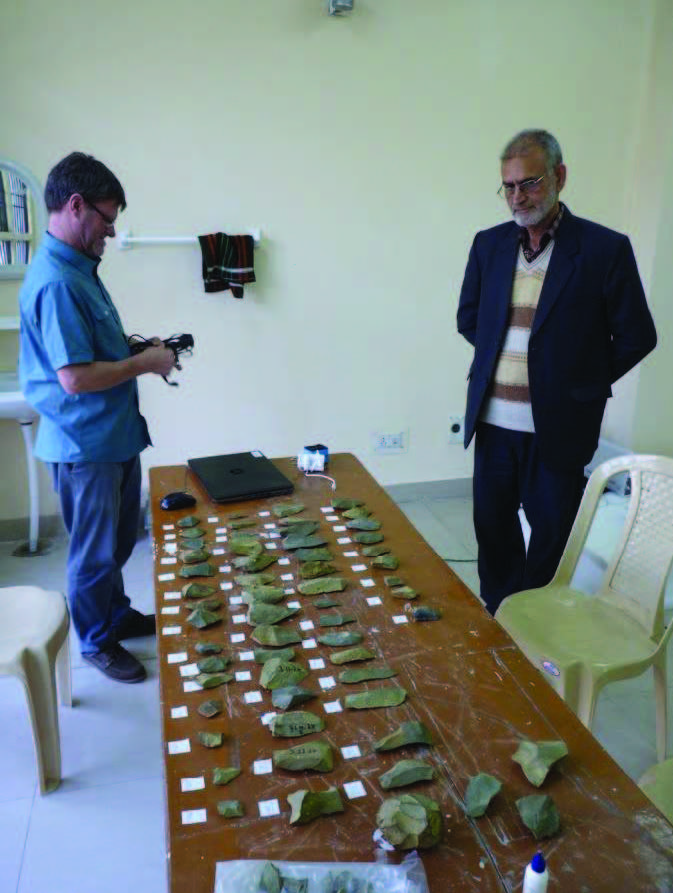This note is in clarification to the interesting feature by Mr. Gautam Kaul published in Greater Kashmir on 15 March regarding the fossils of a reported Mammoth. There were also earlier reporting by your reporter as mentioned in Mr. Kaul’s report.
The essayist had raised certain issues which I would now like to answer in my attempt to bring this case to a happy close and remove all doubts for future.
First, the fossils discovered from Galander Pampore are not of a Mammoth, but an ancient elephant of full major age (about 50 years). Paleontologists from Natural History Museum, London (in 2013) and others who later came to the Wadia Museum of Natural History at Jammu University in 2019 and saw the discovery opined thus. Preliminary taxonomic investigations by the world renowned Palaeontologist working at National Museum of Natural History, Smithsonian Institution, Washington DC, USA remarked that the skull is remarkably well preserved and belongs to a large adult bull elephant. Anatomical features of the skull and preliminary morphological investigations carried out on the skull and mandibles, etc. suggest that this elephant belongs to the genus Palaeoloxodon. The skull possesses a mix of primitive features characteristic of early Pleistocene species of Palaeoloxodon in East Africa and the Middle East, along with most advanced features found in Late Pleistocene Palaeoloxodon namadicus from Indian subcontinent and Palaeoloxodon antiquus from Europe. Further analysis will clarify the exact species this individual belongs to. The stone tools have been confirmed to be insitu (not reworked) tentatively belonging to the beginning of the Middle Palaeolithic age. The recovered fossil is old enough to push the age of the area further in time than what is already on record. The final dating of this fossil is still in progress by foreign experts who could not visit India again (as scheduled) to further examine the material, because of the Covid scare. It is hoped that this work would conclude during the year to follow.
The fossils and stone tools are safe and secured in the Museum of Natural History at the University of Jammu (see the photographs) and are at display for students and common visitors. The story on the whereabouts of the fossil was never countered since the time of its first printing (from 2007 till date) to allow the controversy to settle down. It’s a happy accident of discovery by a fellow Kashmiri (Mr. Gautam Kaul) (after about two decades) who came to be associated with the find and who helped us in our scientific endeavor at the excavation site and later in arranging our meeting with the then Director General, Archeological Survey of India (Shrimati Komal Anand) at New Delhi.
Second, Mr. Kaul has referred to the presence of two students. In fact they were teachers of the GDC Sopore, and not Baramulla, as reported by Mr. Kaul. Perhaps he was led astray by them on the fact at that time hoping to gain his sympathy to the project. But he proved better than that for which I am personally indebted to him.

The fossils remained at site until 2007 but guarded by J&K police personnel only up to 2004. Sometime after 2004 when the police security from the site was removed, some parts of the fossil including eight and a half feet tusk were stolen/destroyed by unknown miscreants. To my surprise I found a huge shopping complex and residential structures built on that spot when I visited the site in 2007 just to see the condition of the fossils there. Subsequently, the remaining parts were shifted out of Kashmir to avoid further theft and damage as they were left unguarded and unattended. I did the shifting with full knowledge of the various concerned authorities and due permission but was roundly criticized for this ‘so called desecration’. It was made clear that the fossils will remain within the State and so the ‘find’ remained in Wadia Museum of Natural History, Jammu University with full knowledge of the Government and the University of Kashmir. Academic rivalry between Kashmir University and Jammu University and myself being a cause in this matter, also led me to shift myself from the Varsity of Kashmir – I loved much.
We have not published this ‘fossil’ find in any scientific journal yet, awaiting the results of final scientific analysis. This could be over 50,000 years of age, and significant since elephants no more roam in the Jammu and Kashmir region and are now seen in south Himachal Siwalik areas and further south. The materials are already on public display available to the interest of the students and general public to extend the horizon of knowledge on the ancient land of the Vedas, for the world to know.
In conclusion I may submit to GK’s esteemed readers that this discovery is of extreme importance for the country. The fossils which were excavated carry cut marks made by the basalt and flint cutting tools to cut out the flesh of the animal for community consumption. This evidence indicates that the hominids who had started moving into the area from West and Central Asia, had developed social traits of working together and specially to hunt together for food. Further, the same social groups had developed the knowledge to fabricate rough implements for use in hunting for their food and in this case, the recovered tools are sophisticated and large in number again suggesting that they were manufactured at site. There is concrete reason to believe that animal life congregated here for drinking water and became target for the early hunters. Efforts are on since 2019 for the early dating of all the materials in the laboratories of London, UK and in the country as the facilities are now available in some sister Universities in India.
Prof. GM Bhat is Professor of Geology, University of Jammu.






